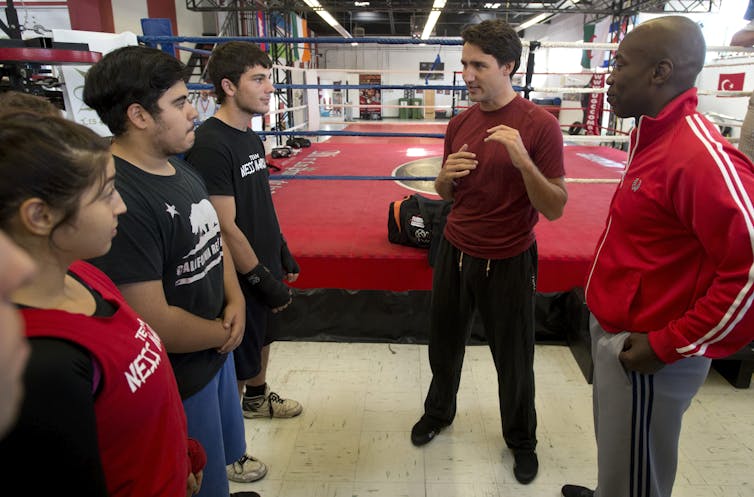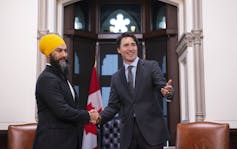Why does Pierre Poilievre appeal to young Canadians? It’s all about economics
Pierre Poilievre’s appeal to young voters, something of a novelty for Canadian Conservative politicians, raises questions about both his popularity and the ability of the Conservative Party of Canada (CPC) to capitalize on the trend over the long term.
Why has Poilievre, unlike his recent predecessors, been successful at gaining support among younger voters, and what impact could this have on the CPC’s electoral coalition?
Conventional political wisdom holds that age has a lot to do with political ideology — while young adults are likely to be liberal, many will become increasingly conservative as they age. In some ways, this is an exaggerated cliché.
Direct measurements of political attitudes more often find that a person’s propensity to be either conservative or liberal is stable over time, regardless of age.
Read news coverage based on evidence, not alarm.
Nevertheless, this conventional wisdom was evident when it came to voting behaviour in Canada. From 2015 to 2019, the Conservative Party of Canada was the most popular choice for Canadian voters over 55, and the Conservatives fell behind the Liberals and the NDP among voters under the age of 34.
Historically, this has hurt the Conservatives while also helping progressive or left-leaning candidates. An influx of support from young voters, for example, played a decisive role in Justin Trudeau’s electoral victory in 2015.

Trudeau is losing young voters
But the voting behaviour of young voters is highly volatile when it comes to both turnout and party preference. Since 2015, Trudeau’s Liberals have lost most of their support among young voters as younger Canadians either supported other parties, became undecided or stopped voting entirely.
Currently, most voters under 34 are, as with most other Canadians, likely to express a lack of confidence in the performance of Trudeau as prime minister.
Most youth support between 2015 and 2021 has instead gone to the NDP and its leader, Jagmeet Singh. By deliberately targeting the demographic through its policy and social media campaigns, the party was the clear favourite of young voters in the 2019 and 2021 elections.

Recently, however, much of this youth support for the Liberals and NDP now appears to be shifting again. For the first time since the 1980s, recent polls show that a plurality, although not a majority, of young voters now support the Conservative Party.
This has been mostly attributed to Poilievre who, more than his rivals for the party leadership, has generated much of this enthusiasm.
Poilievre’s electoral edge?
It’s possible these polls could shift before the next federal election, likely in 2025. But they nonetheless raise the possibility of a novel electoral advantage that a Poilievre-led Conservative party could bring to the next several federal votes.
Poilievre’s growing popularity among young voters is likely due to how he’s seized upon an opening by providing coherent messaging that addresses the general state of dissatisfaction and the economic anxieties that are weighing on young Canadians.
That includes continuing frustrations about the inaccessibility of home ownership, income instability and inflation.
The continuing detrimental economic consequences of the COVID-19 pandemic have also affected this demographic the most, contributing to perceptions of a growing divide between older, economically established generations and younger adults.
This has also created a popular feeling among many young voters that the Trudeau government needs to be replaced.
In addition to a series of missteps and scandals that have eroded Trudeau’s personal popularity, the government is also perceived as being unable to deal with these growing economic concerns.

Because the NDP entered into an agreement with the Liberals allowing them to deliver on beneficial policies like dental-care coverage, the party is now limited in its ability to craft and convey a coherent alternative to the Liberal government.
This is even though New Democrats have, along with Poilievre, been engaging in populist attacks about economic elites for not “paying their fair share.” The NDP’s ongoing support for the Liberals has come at the cost of credibly tapping into a growing anti-Liberal sentiment by compromising their position as a principled adversary — giving Poilievre yet another opening to electoral success.
In contrast, Poilievre offers a coherent, semi-populist appeal that prioritizes these problems, provides a common cause or enemy and proposes solutions within Conservative policies.
Attacking the elites
Poilievre has identified a set of “gatekeepers” that include all-powerful interests and established voices in Canadian public life as the source of these problems, including progressive urbanites, government bureaucrats and financial elites. In working to maintain their privilege, says Poilievre, these gatekeepers have compromised the opportunities available to ordinary Canadians.
Recalibrating these existing institutions to align with a renewed desire for “freedom” is presented as the solution, allowing Poilievre to repackage and legitimize conventional conservative emphases on free markets, deregulation and small government.
His platform’s appeal lies in the fact that it’s simultaneously coherent enough to appeal to Conservative partisans and, at the same time, vague enough to allow young voters to apply their own dissatisfaction or economic anxiety through this gatekeeper/freedom narrative.
Poilievre’s momentum among younger people, if maintained, could bring the CPC a notable electoral advantage in the next election. But given the fact it’s derived from an anti-Liberal sentiment, it’s difficult to determine if it will have a long-term impact.
The party may struggle to retain young voters in the years ahead, likely because younger Canadians care about issues that the Conservatives perform poorly on, like climate change and social equity.
But it’s also possible a much deeper and structural change among younger voters is afoot that is making them more conservative, both economically and socially.
As scholars of populism have argued, the significant economic, social, demographic and technological changes of the last decade have produced a state of displacement and uncertainty that’s pushing emerging adults into conservative politics. If so, it’s good news for Poilievre.

No comments:
Post a Comment